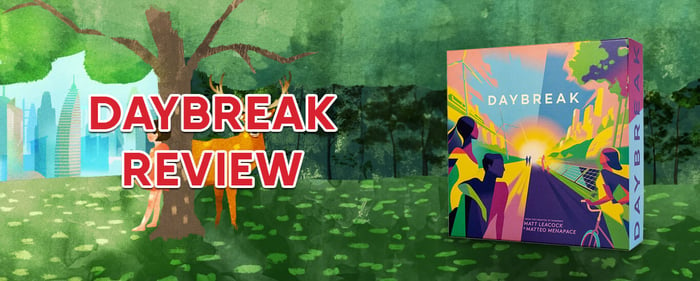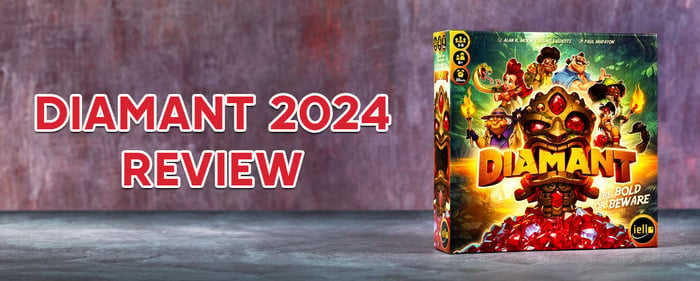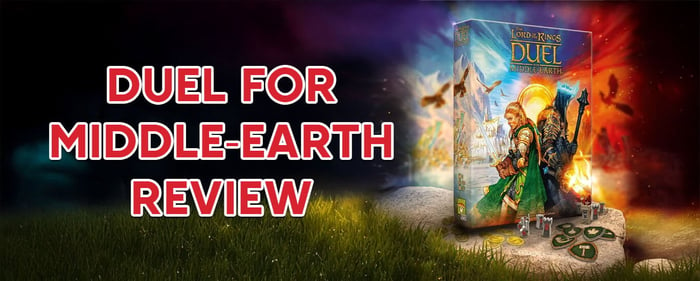Climate change, one card at a time.
The board game industry is incredibly varied and full of games on just about any theme and I love that about board games. I love that, no matter who I am meeting for games, whatever our passions and interests, I will be able to find something that will spark interest and excitement. Daybreak is another example of just how varied and interesting the board game world can be.
Daybreak fits into the category of games that can cross over your hobbies and passions. It is not only great to play (spoiler alert) but makes you stop and think; it can challenge and educate us.
In Daybreak, you come face to face with the very real problem of climate change and are asked the question ‘Can we reverse it?’ Pretty deep for Friday night gaming! The game revolves around realising your carbon emissions and looking at how you use current and emerging technologies to mitigate them, how you can remove dirty energy and replace it with clean, how you can increase the world's natural defences in oceans and forests and how you can make our populations more resilient to the challenges we face moving forward.
Table of Contents
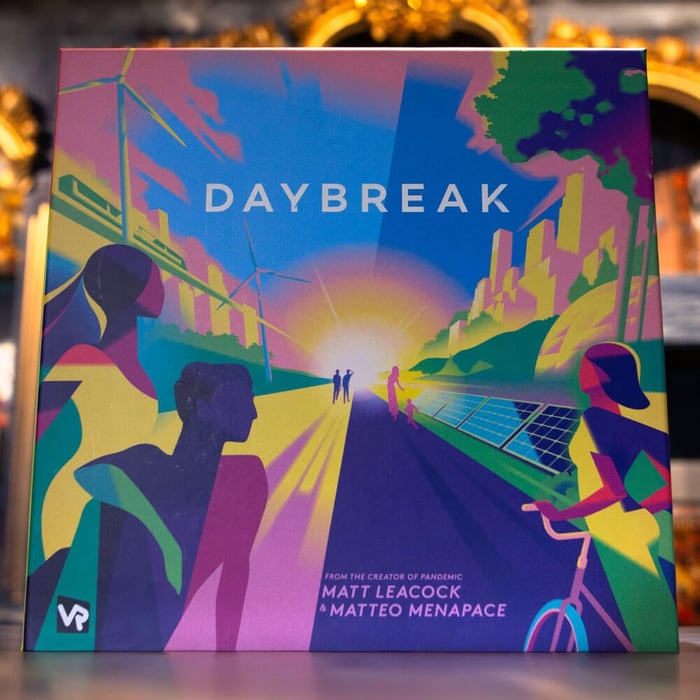 Daybreak Box Art
Daybreak Box Art
Specifications
Mechanics: cooperative, tableau builder, hand management, simultaneous action selection, multiple card tags, planting trees, terrifying carbon production, hopelessly watching the temperature rise
Player Count: 1-4
Play Time: 60 - 90 mins
Ages: 10+
Daybreak is a cooperative game where you are one of the world powers, working together on global projects and sharing technology and resources in this fight for our planet. This has been described in other reviews as the biggest fiction in the game. It gives you a sense that if the nations did work together, we could make a real difference, but it feels a long way from reality! If you want to watch a good review of Daybreak that also speaks more passionately about the climate change issue, I can recommend No Pun Included’s review.
We will come back to this throughout the review, but for now, let's talk about the game.
How to Save the World in Daybreak?
As I said before, Daybreak is a cooperative game with a good pedigree. It was designed by Matt Leacock, the creator of the incredibly popular game Pandemic—a game about cooperatively stopping a global pandemic!
In Daybreak, you are trying to reverse climate change, and you win when you reach drawdown, which is when you remove more carbon from the atmosphere than you produce.
To begin with, you need to choose from one of the 4 world powers: the USA, China, Europe or the all-encompassing Majority world (everyone else). At the start of the game, you are given a player board for your chosen world power. This gives you your first indication of the challenge ahead as you set it up, per your world power instructions, with its energy demand, the breakdown of dirty and clean energy it produces to meet that demand and a long row of carbon-emitting things. These include industries, buildings, transportation, agriculture, fuel extraction and waste. Finally, again, depending on your set-up instructions, you add any social, ecological, or infrastructure resilience tokens and communities in crisis if you start with any.
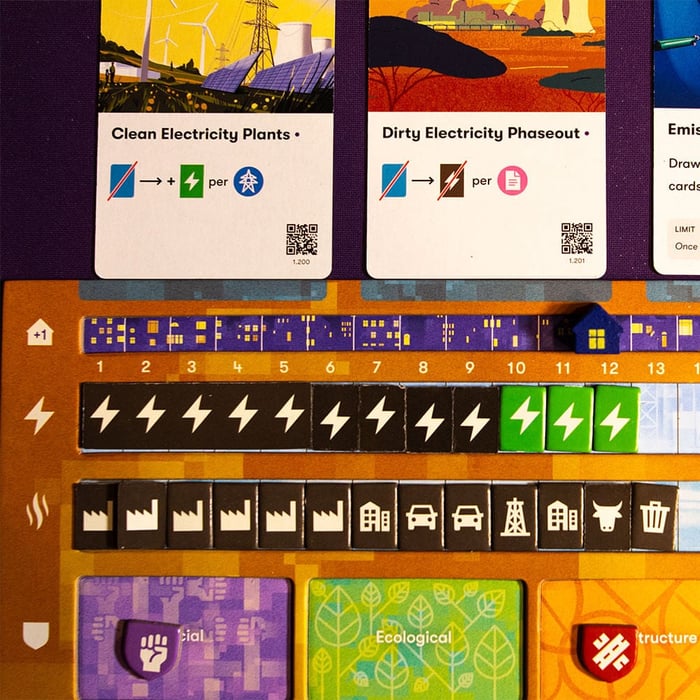 Player Board
Player BoardDuring the game, you will focus mainly on manipulating this board, replacing dirty energy tokens with clean ones, and reducing your emissions tokens to try to minimise your carbon production.
Each world power starts the game with its own set of 5 local projects, which you place above the player board in one of 5 project spaces. This is important; you can only run 5 local projects at any one time. You will need to make difficult choices throughout the game around whether to start new projects or support existing ones to make them stronger - but more on this later.
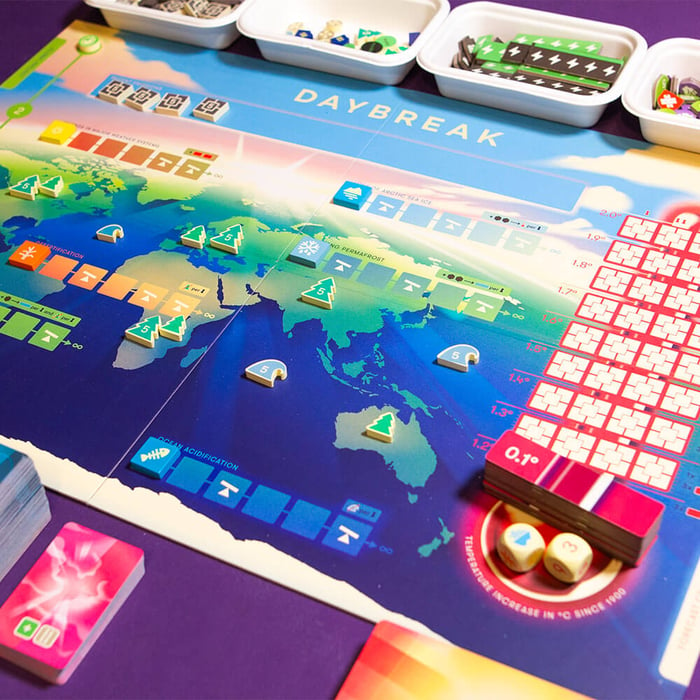 Main Board
Main BoardThe central board is represented by a world map on the table. At the start of the game, depending on player count, you will set up several tree and ocean tokens, which will increase and, more worryingly, decrease throughout the game. It is also home to 8 game trackers. The round tracker is 6 planetary crisis trackers and a thermometer - I will explain these later, but aside from the round tracker and its fast march to the game end, all of these trackers result in bad things happening. Pain and misery.
It's All About The Project
Each world power starts the game with 5 local project cards, which you place above your player board in the 5 indicated spaces. These are effectively your starting actions, which you can use as many times as you would like as long as you have the resources required. An important factor in the game is that you are limited to those 5 project spaces. Throughout the game, you will be making, sometimes quite difficult choices to either start new projects or strengthen existing ones; before we talk more about this, I will explain the 3 different ways a project card can be used.
Firstly, as indicated above, you can choose to start a new project by simply placing it on top of one of the existing projects. This does mean that the project will only be available to you again if something happens, causing you to discard cards, so choose wisely. You can, however, be clever about how you use your actions to maximise your turn. There is nothing wrong with activating one of your projects, then placing a project on top, and then activating that. There are many ways to keep your turn going.
Secondly, you can strengthen an existing project. Daybreak uses game tags on the cards, similar to Terraforming Mars or Ark Nova. There are 12 different tags in Daybreak, each with a unique symbol. You strengthen a project by sliding the card behind an existing project, leaving the tags at the top revealed. Many projects in the game interact with these tags, for example, requiring 3 innovation tags to start the project or an action might improve per certain tag; you might be able to use an action once per round per grid tag or in the case of dirty energy phaseout you remove one dirty energy per regulation tag.
This is one of the brilliant things about this game. As you play, the decisions you make either improve your actions, making them stronger as the game progresses, or when you replace a project (placing it on top), it comes ready stacked with all the tags you had previously added. It makes for some great combinations in the game.
Finally, a project card can be discarded to perform an action, support a global project or mitigate a global crisis - we will come back to this later, but how much fun does that sound?
Your project cards are key to your success in this game, and the 5 you are dealt each turn just don't feel like enough. This is where the ability to use a project and then start a new project on top becomes crucial as it maximises your turn efficiency, but deciding which projects to stop running is hard. There will be some really interesting thoughts to reflect on how many projects we can run simultaneously to effect climate change, but this is not the blog for that!
So What Does a Game Round Look Like? Global Phase
The game round starts with the global phase, a global summit in which you add crisis cards to the board and start a global project.
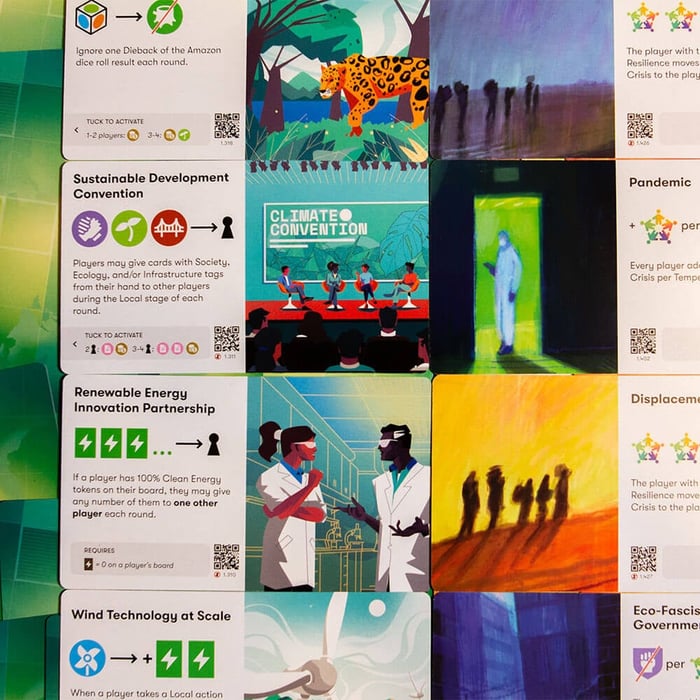 Global Project Cards
Global Project CardsCrisis cards represent things like storms or global financial crises, at the start of each game you add a number to the board based on the temperature tracker. The first card is face up, and you can plan for it, while the others are face down. Through the game, you need to build community, ecological or infrastructure resilience to protect yourself against these crises. Alternatively, you might be able to add cards with a specific tag to mitigate the problems. The result of these cards is bad, not many global crises result in good stuff so you need to prepare for these. At this stage, you are playing the crisis cards. It is at the end of the round that you feel the impact of them.
Global projects give you something you can collaborate to deliver that will bring positive effects. These generally remain for the whole game and can make a real difference but you have to dedicate resources to them which may be a difficult choice to make.
Local Stage
This is where you focus on your player board, draw new project cards, take action to remove emissions and dirty energy or add clean energy, increase resilience, and generally help others.
Remember, to win, we need to reduce carbon emissions or increase how we sequester those emissions. A project might allow you to remove emission tokens from the board, like ‘Net-Zero buildings,’ which allows you to remove building emissions at the expense of increased energy demand. For each emission token you remove, your world power produces one less carbon, and that is crucial, as you will see in the emissions stage.
Emissions Stage
It is at this moment that you realise the task you have in front of you, it is in this stage that you see the impact of your carbon emissions. For every dirty energy token and every emission token, you add one carbon. You dump all of the carbon tokens you have produced between you on the top bar of the global map. You then count how many forest and ocean tokens you have and remove that much carbon - the world's natural defences have dealt with it. Anything left over lands on the temperature track!
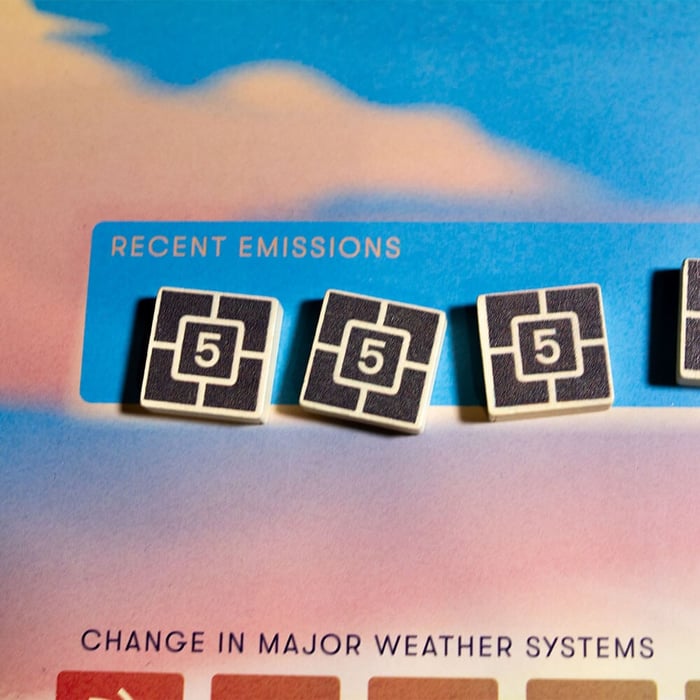 Carbon Tokens
Carbon TokensThis is brutal. In a 2 player game, for every 10 carbon not dealt with, the temperature rises 0.1 degrees, increasing the crisis cards and the other negative planetary effects. This happens at an alarming rate! In our first game in our very first turn, we generated enough additional carbon to raise the temperature bar twice. It feels so difficult, but fixing climate change will never be easy!
Crisis Stage
Two things happen here. As the temperature rises, this might lead to negative planetary effects. Depending on how far you are on the temperature tracker you roll, the planetary effects die. Each side relates to a different planetary effect, for example, loss of arctic sea ice or dieback of the Amazon forest—ultimately, as you would imagine, nothing good can come of this.
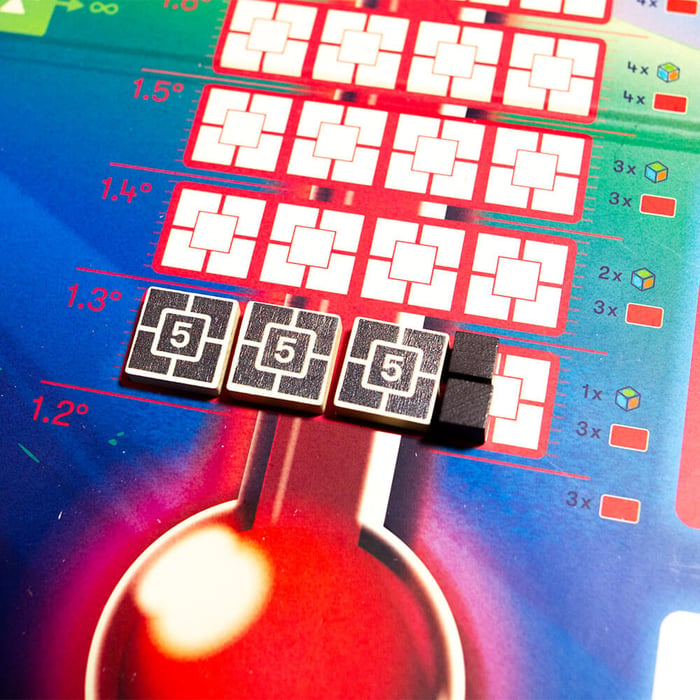 Temperature Tracker
Temperature TrackerOnce you have seen how the planet is being impacted by the temperature rising, you resolve the global crisis cards. You reveal each card one by one and see if you have the resilience to deal with whatever is thrown at you.
This can lead to the reduction of oceans and forests, communities falling into crisis, and your ability to start new projects being reduced.
I like the way they have done this. The more communities are in crisis, the fewer projects you can draw. It symbolises the population being less engaged in climate change projects when things are so tough!
Finally, You Reach the Growth Stage
Firstly, you check to see if you have won the game—ha, right! Then, to represent growth, your nation's energy demand increases. You have to balance reducing dirty energy with increasing clean energy to meet increasing demand. If you can't, you add more communities in crisis, which can mean you are just drawing fewer cards!
Losing The Game
You Lose the game in one of 3 ways:
- The temperature increases by 2.0 degrees,
- You reach 12+ communities in crisis or,
- You haven't won the game by the end of round 6.
The Game Sounds Bleak, But Is It Any Good?
The first time we played this game, it felt impossible. Each turn saw a huge amount of carbon emissions, and a woefully poor amount of that carbon was being dealt with. The temperature tracker just seemed to rocket exponentially, and the crisis cards and negative planetary effects worsened. If I am honest, I was left feeling a little downhearted about the world's situation! This game hits you hard, but when you have taken time to reflect on how we are destroying our planet, you are left with a beautifully crafted game.
The game design is well done, with beautiful artwork on the cards and board, which have a really warm feel to them. The board depicts the sun rising on the globe in a hope-filled way, giving it a real new day vibe. It almost makes you feel optimistic that we can make a difference.
The components are good quality. The forest and ocean tokens are wooden, and the cardboard tokens feel good quality. They have also taken their commitment to sustainability seriously, with no plastics used in the game at all. No textiles have been used, and the wood and paper components are 100% FSC certified! They don't just make you think about climate change as a game; they have done all they can in their game design to minimise their impact.
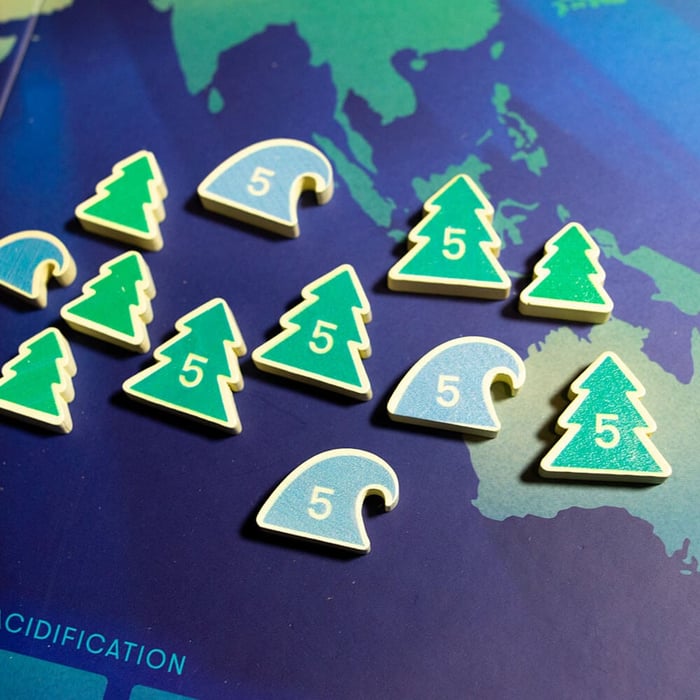 Forest and Ocean Tokens
Forest and Ocean TokensThe cards are not only very pretty but also clean and clear. The imagery and symbols are straightforward and easy to understand and once you know what they mean, the cards need very little referencing to the rule book. On that note, Daybreak boasts a clever QR code system that has been picked up in many reviews. Every card in the game has a QR code in the bottom right corner, which is easy to scan. This takes you to a web page for each card, which not only clarifies any rule questions BUT, quite amazingly, gives you a lot of information on the project the card is representing, what it means, how you can get involved or lobby the government. It is fascinating, but it can take you down a huge rabbit hole that may not be appreciated by your fellow gamers mid-game! This is the first time I have seen anything like this, and it has been done well.
I like the multiple options each card represents but also the hard choices this leads to. A card could be an awesome project in its own right, but the symbols could be just what you need to strengthen another project. I often had to make really hard choices to discard good project cards just to resource other actions, and I felt torn. The card deck, similar to games like Ark Nova and Wingspan, is huge, so every time you play, you will see new projects and synergy. This could be a downside to some as there may be cards you want that never come out. I like the replayability it brings.
The game has a huge amount of action efficiency available. Being able to use a project for its action and then add a project on top, only to use that new action benefitting from previously played symbols, means you can extend your turn far beyond the 5 project spaces you have.
One concern I had before the game was the potential for ‘quarterbacking’, that classic challenge in a cooperative game where people can backseat drive you through your turn. The game encourages you to talk through your turns and ask for advice, and it even recommends that you play with your hand face up on the table. Despite that, because the local stage is simultaneous and you are focusing on your projects and player boards, there is no feeling of someone else telling you what to do.
There is an asymmetrical nature to the game. Each world power starts the game with unique starting projects and a starting set-up of dirty energy and carbon-emitting tokens. This means you must approach the problem differently to the players around you, and your strategy will adapt to the cards you draw.
You will need to collaborate through the game to succeed. You will need to work together to support global projects to unlock new abilities or give you more resilience to crises that might come. Some projects allow you to pass cards to each other, which can be useful if you need certain symbols.
You genuinely feel like you are working together to try and solve a big problem - which is a large understatement. We found the game reasonably difficult. For all the action efficiency and projects available to us, I didn't have enough resources to do what I needed to do, leaving me agonising over how to use the cards available to me.
The game can ramp up quickly once the temperature track starts to creep up, drawing extra crisis cards and rolling more planetary effects each turn.
Though we were not that successful in our attempts to reverse climate change, we enjoyed the gameplay and were left wanting to start again almost immediately, which I think is a sign of a good game. It's the kind of game where you look back, think through your choices, and wonder how you would do it differently next time. I found myself thinking about the game when I wasn't playing it. I got a little bit hooked!
I recommend Daybreak, especially if you are keen on cooperative games and tableau builders with clever game designs that make you think. It's also a game that can lead to really positive conversations around the table. It will get you thinking about the effect on the planet and learning about new technology. To be honest, it could be a little deep, and it is not one for a light-hearted, silly evening.
My slight frustration is that I failed to try the game as a solo game whilst I had a copy of it for the review. This is something I am looking forward to when I pick up my copy!
Score
8 out of 10
![]()
Pros | Cons |
| + Beautiful game design with a clever QR code feature that is just really well done | - Long and fiddly set up |
| + Great tableau building mechanic with the ability to use the project cards in multiple ways | - The game can be impacted by the luck of what project cards come out during your game, with such a large deck of cards you may not get the cards out that would have made a big difference |
| + Really good cooperative experience where you genuinely feel like you need to work together to achieve this task | - High difficulty - not for the faint of heart |
| + Multiple strategies and ways to play | - Watching the world burn and communities collapse can be a little sobering! |
| + If you want to take the extra time you can learn a lot about climate change through the web pages created for the game | |
| + Feel good about reversing climate change |
Daybreak

£49.75
£59.99
Description Daybreak is a cooperative board game about stopping climate change. It presents a hopeful vision of the near future, where you get to build the mind-blowing technologies and resilient societies we need to save the planet. Daybreak is designed… read more
If you are looking for alternative cooperative games with a hard hitting theme you could try Pandemic by the same creator. Work together to stop global disease, the legacy versions are particularly popular!
Alternatively, if you are looking for a noncooperative game using a similar tags system on the cards, why not look at Ark Nova, a game focused on creating a conservation focused zoo?
Looking to pick up something else? Check out our entire collection of board games right here at Gathering Games.
